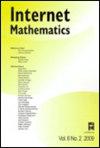Hypergraph Coloring Games and Voter Models
Q3 Mathematics
引用次数: 15
Abstract
Abstract We analyze a network coloring game on hypergraphs that can also describe a voter model. Each node represents a voter and is colored according to its preferred candidate (or undecided). Each hyperedge is a subset of voters that can interact and influence one another. In each round of the game, one hyperedge is chosen randomly, and the voters in the hyperedge can change their colors according to some prescribed probability distribution. We analyze this interaction model based on random walks on the associated weighted directed state graph. Under certain “memoryless” restrictions, we can use semigroup spectral methods to explicitly determine the spectrum of the state graph, and the random walk on the state graph converges to its stationary distribution in O(mlog n) steps, where n is the number of voters and m the number of hyperedges. We can then estimate probabilities that events occur within an error bound of ε by simulating the voting game for O(log (1/ε)mlog n) rounds. We also consider a partially memoryless game using the memoryless game for comparison and analysis, which serves as an approximation of the actual interaction dynamics.超图着色游戏和选民模型
我们分析了一个可以描述选民模型的超图上的网络着色游戏。每个节点代表一个选民,并根据其首选候选人(或未决定的候选人)使用颜色。每个超级边缘都是选民的一个子集,可以相互互动和影响。在每一轮博弈中,随机选择一个超级边缘,超级边缘上的选民可以根据规定的概率分布改变自己的颜色。我们在关联的加权有向状态图上分析了基于随机游动的交互模型。在一定的“无记忆”限制下,我们可以使用半群谱方法显式确定状态图的谱,并且状态图上的随机漫步在O(mlog n)步内收敛到其平稳分布,其中n为选民数,m为超边数。然后,我们可以通过模拟O(log (1/ε)mlog n)轮的投票游戏来估计事件在ε误差范围内发生的概率。我们还考虑使用无记忆游戏进行比较和分析的部分无记忆游戏,这是实际交互动态的近似值。
本文章由计算机程序翻译,如有差异,请以英文原文为准。
求助全文
约1分钟内获得全文
求助全文

 求助内容:
求助内容: 应助结果提醒方式:
应助结果提醒方式:


